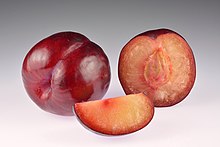
A plum is a fruit of some species in Prunus subg. Prunus. Dried plums are often called prunes, though in the United States they may be labeled as 'dried plums', especially during the 21st century.[1][2]


Plums are likely to have been one of the first fruits domesticated by humans, with origins in East European and Caucasian mountains and China. They were brought to Britain from Asia, and their cultivation has been documented in Andalusia, southern Spain. Plums are a diverse group of species, with trees reaching a height of 5–6 metres (16–20 ft) when pruned. The fruit is a drupe, with a firm and juicy flesh.
China is the largest producer of plums, followed by Romania and Serbia. Japanese or Chinese plums dominate the fresh fruit market, while European plums are also common in some regions. Plums can be eaten fresh, dried to make prunes, used in jams, or fermented into wine and distilled into brandy. Plum kernels contain cyanogenic glycosides, but the oil made from them is not commercially available.
In terms of nutrition, raw plums are 87% water, 11% carbohydrates, 1% protein, and less than 1% fat. They are a moderate source of vitamin C but do not contain significant amounts of other micronutrients.
- ^ "What is the Difference Between Prunes and Dried Plums?". Delighted Cooking. Retrieved 2023-04-01.
- ^ "Prune". Oxford Dictionaries, Oxford University Press. 2018. Archived from the original on September 25, 2016. Retrieved 1 March 2018.